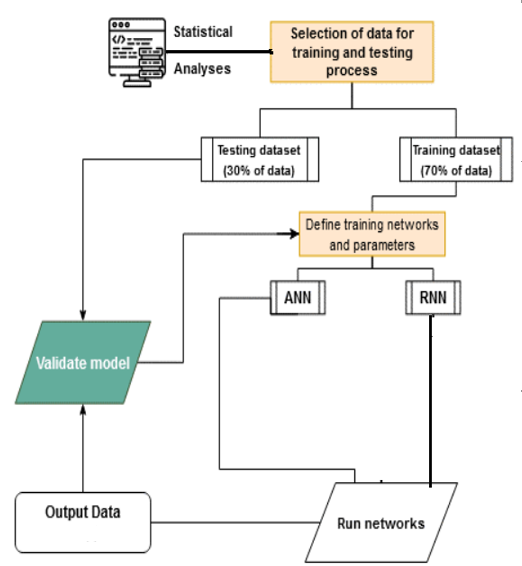Approximation Knowledge-Based Recurrent Neural Network for Estimating N-Terminal Reliability
Main Article Content
Abstract
The main problem dispersed with in this paper is to find a novel method for the improvement in the reliability analysis of Computer Network. Reliability prediction are estimated during the life cycle of a computer network with the aim of estimating failure. In designing a variable size network, the serviceability, availability and reliability of the any network is a primary consideration. The reliability calculation in varying size network is a problem of NP-hard; it requires more calculation and effort with the amplifying no of nodes and links. Many different approaches have been taken for reliability and probability calculation for triumphant communication between any pair of computers. The paper presents a method for identifying n-terminal network reliability based on RNN technique. The method derived in this paper preceding inputs which increases the speed of computation. The approach works efficiently and overcome the difficulties of the previous approaches defined with neural network model and other reliability estimation techniques. It is proposed that the RNN model be used to replace the most time-consuming component of the system reliability evaluation approach. A variable-length sequence input can be handled by RNN. The main goal of this paper is to predict asperity of reliability which is highly correlated with performance of network in any unfavorable conditions.
Article Details
References
Vijay Kumar et.al (2011), “Markov Model for Reliable Packet Delivery in Wireless Sensor Networks”, IJCSI International Journal of Computer Science Issues, Vol. 8, Issue 3, No. 1, ISSN (Online): 1694-0814
Yi-Kuei Lin (2002)“Two-commodity reliability evaluation for a stochastic-flow network with node failure”, Computers & Operations Research, 1927–1939 www.elsevier.com/locate/dsw.
Nader Samaan,(2005) “Using Genetic Algorithms for Reliability Calculations of Complex Power Systems”, 0-7803-8834-8/05, IEEE 10.1109/ISCAS.2005.1465555
Kumar, R. M. Pathak and Y. P. Gupta, (1995) "Genetic-algorithm-based reliability optimization for computer network expansion," in IEEE Transactions on Reliability, vol. 44, no. 1, pp. 63-72, March 1995, doi: 10.1109/24.376523.
Dengiz Berna, Altiparmark Fulya and Smith Alice E.,(1997) “Genetic algorithms design of networks considering allterminal reliability”, The Sixth Industerial Engineering Research Conference Proceedings IERC’97, Miami Beach, Florida, USA, May 17-18, pp. 30-35.
Shuai Lin “Hindawi Complexity Volume (2018), “System reliability assesment based on failure propogation process”,Article ID 9502953, 19 pages https://doi.org/10.1155/2018/9502953
Kerri Morgan,(2016) “An infinite family of 2-connected graphs that have reliability factorisations”, http://dx.doi.org/10.1016/j. dam. 2016. 11.006 0166-218X Elsevier B.V.
Om Prakash Yadav (2020) “All-terminal network reliability estimation using convolutional neural networks”, proc IMechE Part O: J Risk and Reliability 1–14 March 2020, https://doi.org/10.1177 /1748006X20 969465
Baijnath Kaushik,(2015) “Performance evaluation of approximated artificial neural network (AANN) algorithm for reliability improvement”, Applied Soft Computing 303–314 Http://dx.doi.org/10.1016/j.asoc.2014.10.002 1568-4946/©
Leemis, L.M.,(1995) Reliability - Probabilistic Models and Statistical Methods, Prentice Hall, Inc., Englewood Cliffs, New Jersey,
Om Prakash Yadav(2020), "All-terminal network reliability estimation using convolutional neural networks", Journal of Risk and Reliability. https://doi.org/10.1177/1748006X20969465
Khanna G, Chaturvedi SK, Soh S (2019) “On computing the reliability of opportunistic multihop networks with mobile relays.”, Qual Reliability Eng Int. https://doi.org/10.1002/qre.2433
Khanna G, Chaturvedi SK (2018) “A comprehensive survey on multihoop wireless networks: milestones, changing trends and concomitant challenges”, Wireless PersCommun. https://doi.org/10. 1007/s11277-018-5711-8
ZhifuLuan(2017) "Calculation and Simulation of Transmission Reliability in Wireless Sensor Network Based on Network Coding", International Journal of Online Engineering (IJOE).
Baijnath Kaushik(2015) “Performance evaluation of approximated artificial neural network (AANN) algorithm for reliability improvement”, Applied Soft Computing 26 (2015) 303–314.
Chakraborty S, Goyal NK(2015). Irredundant subset cut enumeration for reliability evaluation of flow networks. IEEE Transactions on Reliability 2015;64(4):1194–1202.
S. Chakraborty and N. K. Goyal(2015), “Irredundant subset cut enumeration for reliability evaluation of flow networks,” IEEE Trans. Rel., vol. 64, no. 4, pp. 1194–1202,
F. Altiparmak, B. Dengiz(2014) “Design of reliable communication networks: A hybrid ant colony optimization algorithm” IIE Transactions, 42:4, 273-287, DOI: 10.1080/07408170903039836
B Kaushik(2013) “Achieving maximum reliability in fault tolerant network design for variable networks”, Applied Soft Computing 13 (7), 3211-3224.
Wei-Chang et.al (2010), “A Particle Swarm Optimization Approach Based on Monte Carlo Simulation for Solving the Complex Network Reliability Problem”, IEEE Transactions on Reliability 59(1):212 – 221
Mutawa, A. M., Alazemi, H. M. K., &Rayes(2009), A. “A novel steady-state genetic algorithm approach to the reliability optimization design problem of computer networks”. International Journal of Network Management, 19(1), 39–55. doi:10.1002/nem.687, (2009).

